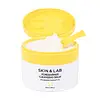What's inside
What's inside
 Key Ingredients
Key Ingredients

 Benefits
Benefits

 Concerns
Concerns

No concerns
 Ingredients Side-by-side
Ingredients Side-by-side

Water
Skin ConditioningSodium Lactate
BufferingSuccinic Acid
Buffering1,2-Hexanediol
Skin ConditioningGlycerin
HumectantPropanediol
SolventPanthenol
Skin ConditioningAllantoin
Skin ConditioningCaffeine
Skin ConditioningCaprylyl Glycol
EmollientButylene Glycol
HumectantLactobacillus Ferment Lysate
Skin ConditioningPolyglyceryl-10 Laurate
Skin ConditioningEthylhexylglycerin
Skin ConditioningXanthan Gum
EmulsifyingPentylene Glycol
Skin ConditioningDisodium EDTA
Acetyl Glucosamine
Skin ConditioningCynanchum Atratum Extract
Skin ConditioningSodium Hyaluronate
HumectantHydroxyacetophenone
AntioxidantCitrus Aurantium Dulcis Peel Oil
MaskingAlthaea Rosea Flower Extract
Skin ConditioningSodium Hyaluronate Crosspolymer
HumectantDipropylene Glycol
HumectantCaprylyl/Capryl Glucoside
CleansingCeramide NP
Skin ConditioningCholesterol
EmollientHydrogenated Lecithin
EmulsifyingLinolenic Acid
CleansingWater, Sodium Lactate, Succinic Acid, 1,2-Hexanediol, Glycerin, Propanediol, Panthenol, Allantoin, Caffeine, Caprylyl Glycol, Butylene Glycol, Lactobacillus Ferment Lysate, Polyglyceryl-10 Laurate, Ethylhexylglycerin, Xanthan Gum, Pentylene Glycol, Disodium EDTA, Acetyl Glucosamine, Cynanchum Atratum Extract, Sodium Hyaluronate, Hydroxyacetophenone, Citrus Aurantium Dulcis Peel Oil, Althaea Rosea Flower Extract, Sodium Hyaluronate Crosspolymer, Dipropylene Glycol, Caprylyl/Capryl Glucoside, Ceramide NP, Cholesterol, Hydrogenated Lecithin, Linolenic Acid
Ingredients Explained
These ingredients are found in both products.
Ingredients higher up in an ingredient list are typically present in a larger amount.
Caprylyl Glycol is a humectant and emollient, meaning it attracts and preserves moisture.
It is a common ingredient in many products, especially those designed to hydrate skin. The primary benefits are retaining moisture, skin softening, and promoting a healthy skin barrier.
Though Caprylyl Glycol is an alcohol derived from fatty acids, it is not the kind that can dry out skin.
This ingredient is also used as a preservative to extend the life of products. It has slight antimicrobial properties.
Learn more about Caprylyl GlycolEthylhexylglycerin (we can't pronounce this either) is commonly used as a preservative and skin softener. It is derived from glyceryl.
You might see Ethylhexylglycerin often paired with other preservatives such as phenoxyethanol. Ethylhexylglycerin has been found to increase the effectiveness of these other preservatives.